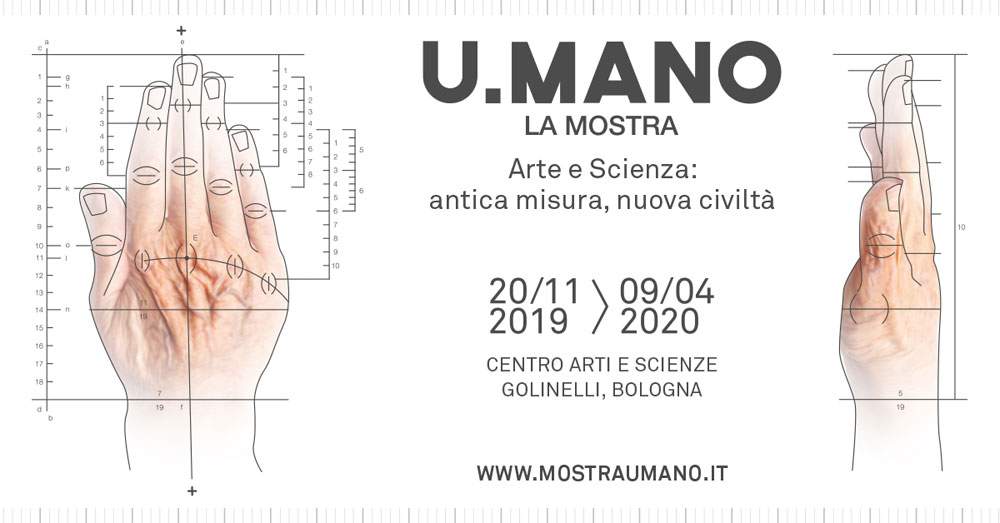Golinelli Foundation focuses an exhibition on the hand as an emblem of the link between art and science
The Golinelli Foundation in Bologna presents from November 20, 2019 to April 9, 2020 the exhibition U.MANO - Art and Science: ancient measure, new civilization; curated by Andrea Zanotti with Silvia Evangelisti, Carlo Fiorini and Stefano Zuffi, the exhibition is dedicated to the hand interpreted in theexploration of man’s interiority and understanding of the surrounding universe, in close connection with the brain. The theme of the hand is representative of Fondazione Golinelli’s own intention, which is to recover that connection between art and science.
"The ancient alliance that once held art and science together implied insights of the mind and works of the hands aimed at the search for that discontinuity that nourishes human progress. Indeed, it is true that we can investigate the face of the future through probability calculus and computational capacity that touch the highest pinnacle today in big data; but it is also true that the intuition of the future lies in the lonely and painful anticipations of scientists and artists peering into horizons foreclosed to us. It is the solitude of Leonardo who imagines four hundred years in advance man’s ability to fly," says Andrea Zanotti, president of Fondazione Golinelli.
In the Golinelli Arts and Sciences Center, where the exhibition will be set up, the exhibition will kick off with two large central installations: closed hands, a symbol of reflection on one’s origin and interiority, and open hands, an emblem of exploration and knowledge of the world around us. These are a play on symmetry and were developed from the digitization of founder Marino Golinelli’s right hand.
In the space created by the sculpture of the closed hands will be placed De Symmetria partium in rectis formis humanorum corporum libri, Albrecht Dürer ’s treatise on drawing the human figure. This has been interpreted as one of the earliest algorithms of generative art, which was applied to transform the dimensions of the hand into frequencies and ratios between them, thus obtaining its sounds. Also present are two anatomical atlases: the De humani corporis fabrica by Andrea Vesalius and the Deux Livres de chirurgie by Ambroise Paré.
The third installation depicts the hand-brain, an augmented sculpture that invites the public to understand how we observe. The exhibition also features paintings made between the 16th and 17th centuries, such as Madonna and Child attributed to Caravaggio, Judith and Holofernes by Giovan Battista Crespi, Christ of the Coin by Mattia Preti, Madonna and Child by Ludovico Carracci and St. John the Baptist by Guercino, and Portrait of Francesco Arsilli by Sebastiano del Piombo.
It continues with an index finger pointing toward the sky; reinterpreted by Michelangelo Pistoletto, this indicates an idea of creation different from that of ancient tradition, where the touch of the hand represents the link between creator and created, initiating man into knowledge and inviting him to develop his own potential.
The bionic limb, on the other hand, is a work of advanced engineering created by young researchers from BionIt Labs srl, one of the start-ups operating in the G-Factor incubator-accelerator, who designed an innovative limb adaptable to each patient.
Finally, through a gamification workshop, the exhibition set-up was reconstructed in 3D, where objects, characters, and fragments of information appear to relive the story of The Battle of Anghiari in the vision of the young creators of the game.
For info: www.mostraumano.it
Hours: Tuesday to Friday 10 a.m. to 7 p.m.; Saturday and Sunday 11 a.m. to 8 p.m.
Tickets: full 10 euros, reduced 8 euros.
 |
| Golinelli Foundation focuses an exhibition on the hand as an emblem of the link between art and science |
Warning: the translation into English of the original Italian article was created using automatic tools. We undertake to review all articles, but we do not guarantee the total absence of inaccuracies in the translation due to the program. You can find the original by clicking on the ITA button. If you find any mistake,please contact us.



























